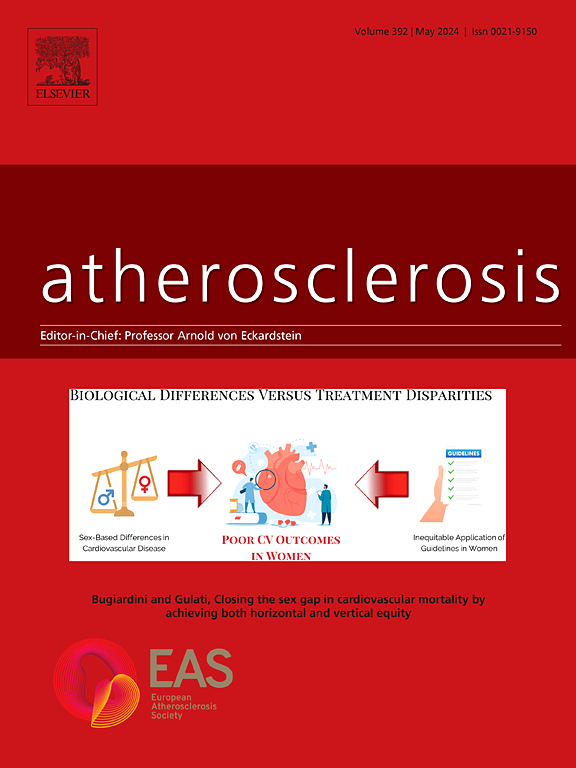PCSK9 inhibitor experiences and preferences of patients and healthcare professionals in decision-making: A mixed methods study
IF 4.9
2区 医学
Q1 CARDIAC & CARDIOVASCULAR SYSTEMS
引用次数: 0
Abstract
Background and aims
This study investigated how patients experience and which outcomes matter to patients and healthcare professionals in the decision to initiate proprotein convertase subtilisin/kexin type 9 inhibitors (PCSK9i) as add-on lipid-lowering treatment (LLT).
Methods
We performed a mixed methods study: very high-risk patients qualifying for PCSK9i reimbursement were interviewed about their experiences and preferences. Subsequently, patients using PCSK9i completed an anonymous online survey about their experiences. Additionally, healthcare professionals (HCPs) filled in an online survey about their PCSK9i prescription preferences and perceived patient preferences.
Results
We interviewed 25 patients (median [IQR] age 58 [48–65] years, 56 % women, 64 % established cardiovascular disease) at different decision-making stages. The majority (72 %) chose efficacy over side-effects (16 %) and ease of use (12 %) as most important attribute of add-on LLT. Most patients (72 %) prefer shared decision-making. Subsequently, 170 patients using PCSK9i completed a survey (age 64 [56–69], 44 % women, 63 % established cardiovascular disease). Here again, the most important attribute (83 %) in deciding on add-on LLT was efficacy. Almost all (90 %) patients favoured shared decision-making. Of the 59 HCPs (age 44 [40–50], 49 % women, 78 % medical specialist), only 27 % indicated to consider patient preferences when selecting the PCSK9i type. HCPs identified patient characteristics influencing their PCSK9i prescription preferences.
Conclusions
For patients and HCPs, efficacy was the most important aspect in choosing a PCSK9i. Even though shared decision-making is recommended by the guidelines and preferred by patients, in clinical practice only a minority of the HCPs apply this. To facilitate shared decision-making, future research should investigate the development and impact of a decision aid for patients.

PCSK9抑制剂在患者和医疗保健专业人员决策中的经验和偏好:一项混合方法研究
背景和目的:本研究调查了患者在决定启动蛋白转化酶枯草杆菌素/酮素9型抑制剂(PCSK9i)作为附加降脂治疗(LLT)时的经历,以及哪些结果对患者和医疗保健专业人员有影响。方法:我们进行了一项混合方法研究:对符合PCSK9i报销条件的高危患者进行访谈,了解他们的经历和偏好。随后,使用PCSK9i的患者完成了一份关于他们经历的匿名在线调查。此外,医疗保健专业人员(HCPs)填写了一份关于他们的PCSK9i处方偏好和感知到的患者偏好的在线调查。结果:我们在不同的决策阶段采访了25例患者(中位[IQR]年龄58[48-65]岁,56%为女性,64%为心血管疾病)。大多数(72%)的人选择疗效超过副作用(16%)和易用性(12%)作为附加LLT最重要的属性。大多数患者(72%)更喜欢共同决策。随后,170例使用PCSK9i的患者完成了调查(年龄64岁[56-69],44%为女性,63%已确诊心血管疾病)。在这里,决定附加LLT的最重要属性(83%)是疗效。几乎所有(90%)患者都赞成共同决策。在59名HCPs(44岁[40-50岁],49%为女性,78%为专科医生)中,只有27%表示在选择PCSK9i型时考虑患者偏好。HCPs确定了影响其PCSK9i处方偏好的患者特征。结论:对于患者和HCPs来说,疗效是选择PCSK9i最重要的方面。尽管共同决策是指南推荐的,也是患者的首选,但在临床实践中,只有少数HCPs采用这种做法。为了促进共同决策,未来的研究应调查决策辅助的发展和对患者的影响。
本文章由计算机程序翻译,如有差异,请以英文原文为准。
求助全文
约1分钟内获得全文
求助全文
来源期刊

Atherosclerosis
医学-外周血管病
CiteScore
9.80
自引率
3.80%
发文量
1269
审稿时长
36 days
期刊介绍:
Atherosclerosis has an open access mirror journal Atherosclerosis: X, sharing the same aims and scope, editorial team, submission system and rigorous peer review.
Atherosclerosis brings together, from all sources, papers concerned with investigation on atherosclerosis, its risk factors and clinical manifestations. Atherosclerosis covers basic and translational, clinical and population research approaches to arterial and vascular biology and disease, as well as their risk factors including: disturbances of lipid and lipoprotein metabolism, diabetes and hypertension, thrombosis, and inflammation. The Editors are interested in original or review papers dealing with the pathogenesis, environmental, genetic and epigenetic basis, diagnosis or treatment of atherosclerosis and related diseases as well as their risk factors.
 求助内容:
求助内容: 应助结果提醒方式:
应助结果提醒方式:


